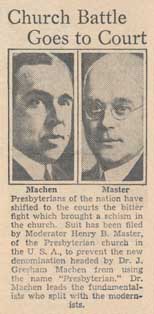In 1973, conservative Presbyterians left the old Southern Presbyterian denomination and formed The National Presbyterian Church. A year later, when it became known that there was a name conflict with another organization, the young denomination chose to simply change its name, and soon selected the name, Presbyterian Church in America (PCA).
The Orthodox Presbyterian Church (OPC) has a somewhat similar story. That denomination was originally organized in 1936 under the name of The Presbyterian Church of America. However, in this latter case, the mother church—the one they had left—filed a lawsuit against the new denomination, seeking to prohibit their use of that name. Finally, in 1938, the defendants lost their case and were forced to adopt a new name. [Correction: My counterpart in the OPC, John Muether, was good to note that rather than actually losing their case in court, the OPC instead came to the conclusion that they did not have the resources to pursue the case through the courts, and so surrendered rather than spend more money and time on the fight.] Since that time the denomination has been known as The Orthodox Presbyterian Church. The following several news clippings come from the collection of the Rev. Henry G. Welbon, preserved at the PCA Historical Center.
 Philadelphia Bulletin, August 20, 1936:
Philadelphia Bulletin, August 20, 1936:
Fight for Name of Presbyterian.
New Body Engages Counsel to Defend Its Use of the Title
General Assembly Suit
Machen-Fundamentalist Presbyterians said today that they intend to make a vigorous legal fight to retain their right to use the name of the Presbyterian Church of America.
This decision comes as a result of the filing of a suit by the General Assemlbyof the Presbyterian Church in the U.S.A.–the parent organization—Aug. 13, in which the use of that name by the new body is contested.
“The Presbyterian Church of America,” said the Rev. Edwin H. Rian, general secretary of the Committee on Home Missions and Church Extension of the new Presbyterian body, “has retained a well known Philadelphia law firm to represent it in the suit.
“The Rev. H. McAllister Griffiths, D.D., has been employed to act as ecclesiastical counsel. Dr. Griffiths is regarded as an authority in Presbyterian law.
“Through its counsel, The Presbyterian Church of America expects to make a vigorous fight to protect its right to the use of that name.
“The very essence of religious liberty is involved in this case. Christians in every church will want to know if one church body can dictate to another.
“The Presbyterian Church of America has no desire to enter the civil courts, but the action of the Presbyterian Church in the U.S.A. has made it obligatory. The Presbyterian Church of America will fight this case to a finish.”
New York Times, August 20, 1936, p. 23:
CHURCH GETS COUNSEL
Seceding Presbyterians Prepare to Fight Injunction Suit.
Philadelphia, August 19. — The Presbyterian Church of America, organized here in June by seceding Fundamentalists, prepared today to defend itself against an injunction suit filed in Commons Pleas Court last week by the parent denomination, the Presbyterian Church in the United States of America.
The defendant group announced that the firm of Sault, Ewing, Remick & Saul of this city will serve as its legal counsel, with the Rev. Dr. H. McAllister Griffiths of The Presbyterian Guardian, acting as ecclesiastical counsel.
The parent church is seeking to enjoin the secessionists from using the name Presbyterian, or any similar name or one with similar import, in the title of their organization.
 Lawrence, MA Evening Tribune, August 21, 1936:
Lawrence, MA Evening Tribune, August 21, 1936:
Church Battle Goes to Court
Presbyterians of the nation have shifted to the courts the bitter fight which brought a schism in the church. Suit has been filed by Moderator Henry B. Master, of the Presbyterian Church in the U.S.A., to prevent the new denomination headed by Dr. J. Gresham Machen from using the name “Presbyterian.” Dr. Machen leads the fundamentalists who split with the modernists.
Words to Live By:
“A good name is to be chosen rather than great riches, and favor is better than silver or gold.” (Proverbs 22:1, ESV)
Set a guard over your tongue, and watch carefully your actions before men. In all that you say, in all that you do, live to the glory of our Lord and our God.

